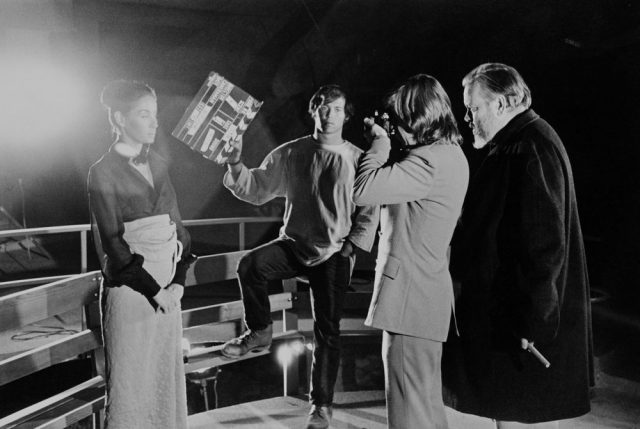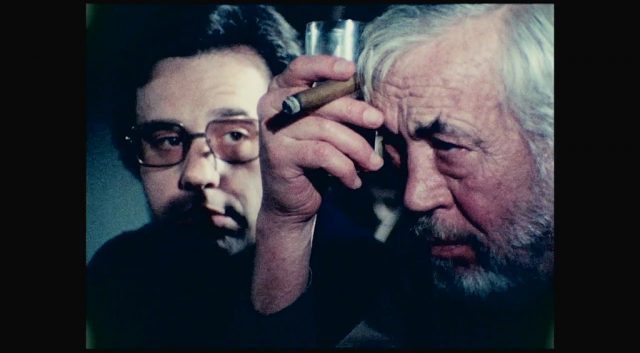
Orson Welles on the set of his final film, The Other Side of the Wind
THE OTHER SIDE OF THE WIND (Orson Welles, 2018)
MoMA Film, Museum of Modern Art
11 West 53rd St. between Fifth & Sixth Aves.
Sunday, November 11, 5:00
Series runs through January 8
212-708-9400
www.moma.org
Throughout Orson Welles’s The Other Side of the Wind, characters make declarations that have been applied to Welles’s work over the years, and what audiences may even be thinking in the first minutes of this, his final film: “Does all this matter?” “What the hell is that?” “I’m bored with the whole story.” “You could tell me what’s going on here.” And “What happens here?” “I’m not really sure, Max.” But that wickedly sly self-referential commentary is one of the many reasons that The Other Side of the Wind is yet another masterpiece by the man who brought the world Citizen Kane, The Magnificent Ambersons, Touch of Evil, F for Fake, and other classics. Welles’s legendary difficulties — budgetary problems, editing and reshoots without his consent, productions that took years to finish — are both the subject and the story of the making of The Other Side of the Wind itself. Welles’s potent skewering of Hollywood was shot in the 1970s and remained incomplete until now; finally, nearly one hundred hours of footage have been edited into a two-hour gem that will be screening November 11 at MoMA in their annual “Contenders” series, made up of films the institution believes will last the test of time. The Other Side of the Wind begins with an equilibrium-challenging blast of grainy scenes photographed with shaky handheld cameras and sudden, disorienting closeups, switching from color to black-and-white, the audio track not quite synced, Michel Legrand’s jazzy noir score underlining the too-rapid pace as all the main characters are introduced. The conceit of the film is that it tells the story of the last day of iconic, ornery auteur J. J. Hannaford’s life, played by iconic, ornery auteur John Huston. (Welles always claimed that Hannaford was not based on himself but on other great directors.) “This little historical document has been put together from many sources,” Hannaford acolyte Brooks Otterlake (Peter Bogdanovich) announces in voice-over at the start, “from all the footage shot by TV and documentary filmmakers and also the students, critics, and young directors who happened to bring 16- and 8mm cameras, having been invited to Jake’s seventieth birthday party.”

Peter Bogdanovich and John Huston star in Orson Welles’s The Other Side of the Wind
Once the film calms down, it’s stupendous, a bittersweet takedown of the studio system and the end of an era, with a fabulous cast that covers nearly every aspect of the film world: Susan Strasberg as ruthless, ambitious critic Julie Rich; Edmond O’Brien as actor Pat Mullins; Mercedes McCambridge as Maggie Noonan, Hannaford’s manager; Norman Foster as Billy Boyle, an old-timer who knows how to handle things; Paul Stewart as Matt Costello, another of Hannaford’s old cohorts; Lilli Palmer as movie star Zarah Valeska, the host of the party; Cameron Mitchell as grumbling makeup artist Zimmie; Pat McMahon as journalist Marvin P. Fassbender; Joseph McBride as critic Pister; Tonio Selwart as a financier known only as the Baron; Howard Grossman as biographer Charles Higgam; Geoffrey Land as studio head Max David; Frank Marshall as one of the documentarians; Cathy Lucas as Mavis Henscher, a young woman Hannaford takes a liking to; Stafford Repp (Chief O’Hara on Batman) as Hannaford supporter Al Denny; Dennis Hopper as director Lucas Renard; Benny Rubin as Hollywood agent Abe Vogel; Gregory Sierra as screenwriter Jack Simon, who keeps throwing barbs at Hannaford; and Dan Tobin as the uptight Dr. Bradley Pease Burroughs. Among those being parodied or paid homage to in the casting and the plot are Marlene Dietrich, John Houseman, John Ford, William Wellman, Pauline Kael, Robert Evans, Charles Higham, Cybill Shepherd, and John Milius. Among the party guests are George Jessel, Curtis Harrington, Henry Jaglom, Paul Mazursky, Claude Chabrol, Cameron Crowe, Les Moonves, and Rich Little, who originally played Otterlake but was replaced by Bogdanovich, who extensively interviewed Welles for the seminal book This Is Orson Welles. (And yes, that man in the bathroom stall is William Katt, who would later become the Greatest American Hero, while 1970s/’80s star Cassie Yates is Martine.)
Cinematographer Gary Graver and editor Bob Murawski have done what must have been a nearly impossible job, creating a compelling narrative that interweaves the many styles with the making of Hannaford’s last film, also called The Other Side of the Wind, a somewhat existential erotic tale of a Native American woman played by an unnamed actress (Oja Kodar, Welles’s companion) who’s being followed by a motorcycle rebel portrayed by first-time actor John Dale (Bob Random), a new discovery of Hannaford’s. The film is Hannaford’s attempt to remain relevant in the modern age; it’s shot in bold colors, with plenty of nudity and a hip score that serve as a stark counterpoint to the predominantly black-and-white footage of Hannaford and his exploits. “It’s a whole new business,” Zimmie laments. The Other Side of the Wind is a fitting coda to Welles’s career — although he does not appear in the film, his voice can be heard off-camera at one point — a grand finale lovingly put together with respect and admiration that once again makes us wonder what Welles could have achieved had he not continually run into so much trouble as a filmmaker. The MoMA screening will be followed by a Q&A with producer Filip Jan Rymsza. It will be preceded at 2:00 by Morgan Neville’s overly fanciful They’ll Love Me When I’m Dead, which goes behind-the-scenes of The Other Side of the Wind, detailing the making of the movie through interviews with many of the participants while also delving into Welles’s working process, fundraising methods, and, of course, genius. It’s narrated by Alan Cumming and features Bogdanovich, Kodar, Shepherd, Jaglom, Graver, Random, Marshall, Little, Mitchell, McBride, Simon Callow, George Stevens Jr., Jeanne Moreau, Danny Huston, and others. Neville will take part in a Q&A after the screening.